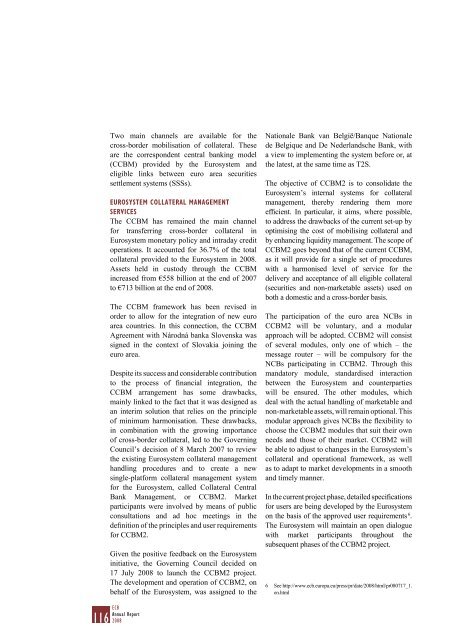ANNUAL REPORT 2008 - Polymer Bank Notes of the World
ANNUAL REPORT 2008 - Polymer Bank Notes of the World
ANNUAL REPORT 2008 - Polymer Bank Notes of the World
Create successful ePaper yourself
Turn your PDF publications into a flip-book with our unique Google optimized e-Paper software.
Two main channels are available for <strong>the</strong>cross-border mobilisation <strong>of</strong> collateral. Theseare <strong>the</strong> correspondent central banking model(CCBM) provided by <strong>the</strong> Eurosystem andeligible links between euro area securitiessettlement systems (SSSs).EUROSYSTEM COLLATERAL MANAGEMENTSERVICESThe CCBM has remained <strong>the</strong> main channelfor transferring cross-border collateral inEurosystem monetary policy and intraday creditoperations. It accounted for 36.7% <strong>of</strong> <strong>the</strong> totalcollateral provided to <strong>the</strong> Eurosystem in <strong>2008</strong>.Assets held in custody through <strong>the</strong> CCBMincreased from €558 billion at <strong>the</strong> end <strong>of</strong> 2007to €713 billion at <strong>the</strong> end <strong>of</strong> <strong>2008</strong>.The CCBM framework has been revised inorder to allow for <strong>the</strong> integration <strong>of</strong> new euroarea countries. In this connection, <strong>the</strong> CCBMAgreement with Národná banka Slovenska wassigned in <strong>the</strong> context <strong>of</strong> Slovakia joining <strong>the</strong>euro area.Despite its success and considerable contributionto <strong>the</strong> process <strong>of</strong> financial integration, <strong>the</strong>CCBM arrangement has some drawbacks,mainly linked to <strong>the</strong> fact that it was designed asan interim solution that relies on <strong>the</strong> principle<strong>of</strong> minimum harmonisation. These drawbacks,in combination with <strong>the</strong> growing importance<strong>of</strong> cross-border collateral, led to <strong>the</strong> GoverningCouncil’s decision <strong>of</strong> 8 March 2007 to review<strong>the</strong> existing Eurosystem collateral managementhandling procedures and to create a newsingle-platform collateral management systemfor <strong>the</strong> Eurosystem, called Collateral Central<strong>Bank</strong> Management, or CCBM2. Marketparticipants were involved by means <strong>of</strong> publicconsultations and ad hoc meetings in <strong>the</strong>definition <strong>of</strong> <strong>the</strong> principles and user requirementsfor CCBM2.Given <strong>the</strong> positive feedback on <strong>the</strong> Eurosysteminitiative, <strong>the</strong> Governing Council decided on17 July <strong>2008</strong> to launch <strong>the</strong> CCBM2 project.The development and operation <strong>of</strong> CCBM2, onbehalf <strong>of</strong> <strong>the</strong> Eurosystem, was assigned to <strong>the</strong>Nationale <strong>Bank</strong> van België/Banque Nationalede Belgique and De Nederlandsche <strong>Bank</strong>, witha view to implementing <strong>the</strong> system before or, at<strong>the</strong> latest, at <strong>the</strong> same time as T2S.The objective <strong>of</strong> CCBM2 is to consolidate <strong>the</strong>Eurosystem’s internal systems for collateralmanagement, <strong>the</strong>reby rendering <strong>the</strong>m moreefficient. In particular, it aims, where possible,to address <strong>the</strong> drawbacks <strong>of</strong> <strong>the</strong> current set-up byoptimising <strong>the</strong> cost <strong>of</strong> mobilising collateral andby enhancing liquidity management. The scope <strong>of</strong>CCBM2 goes beyond that <strong>of</strong> <strong>the</strong> current CCBM,as it will provide for a single set <strong>of</strong> procedureswith a harmonised level <strong>of</strong> service for <strong>the</strong>delivery and acceptance <strong>of</strong> all eligible collateral(securities and non-marketable assets) used onboth a domestic and a cross-border basis.The participation <strong>of</strong> <strong>the</strong> euro area NCBs inCCBM2 will be voluntary, and a modularapproach will be adopted. CCBM2 will consist<strong>of</strong> several modules, only one <strong>of</strong> which – <strong>the</strong>message router – will be compulsory for <strong>the</strong>NCBs participating in CCBM2. Through thismandatory module, standardised interactionbetween <strong>the</strong> Eurosystem and counterpartieswill be ensured. The o<strong>the</strong>r modules, whichdeal with <strong>the</strong> actual handling <strong>of</strong> marketable andnon-marketable assets, will remain optional. Thismodular approach gives NCBs <strong>the</strong> flexibility tochoose <strong>the</strong> CCBM2 modules that suit <strong>the</strong>ir ownneeds and those <strong>of</strong> <strong>the</strong>ir market. CCBM2 willbe able to adjust to changes in <strong>the</strong> Eurosystem’scollateral and operational framework, as wellas to adapt to market developments in a smoothand timely manner.In <strong>the</strong> current project phase, detailed specificationsfor users are being developed by <strong>the</strong> Eurosystemon <strong>the</strong> basis <strong>of</strong> <strong>the</strong> approved user requirements 6 .The Eurosystem will maintain an open dialoguewith market participants throughout <strong>the</strong>subsequent phases <strong>of</strong> <strong>the</strong> CCBM2 project.See 6 http://www.ecb.europa.eu/press/pr/date/<strong>2008</strong>/html/pr080717_1.en.html116 ECBAnnual Report<strong>2008</strong>




![KNOW YOUR NEW GIBRALTAR BANKNOTES - [Home] bThe/b](https://img.yumpu.com/50890985/1/184x260/know-your-new-gibraltar-banknotes-home-bthe-b.jpg?quality=85)
![PAPUA NEW GUINEA - [Home] - Polymer Bank Notes of the World](https://img.yumpu.com/49758743/1/190x143/papua-new-guinea-home-polymer-bank-notes-of-the-world.jpg?quality=85)










